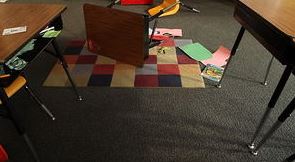The recent treatment of a black teenage girl in South Carolina by former white school resource officer Ben Fields has educators, parents and activists debating whether police force is an appropriate behavior management strategy for schools or contributes to the school to prison pipeline.
When we reflexively label student opposition as defiant, we diminish our opportunity to recognize their resistance, a natural adaptation we can tap into to promote learning. Defiance is perceived as an “open disregard or contempt; a challenge to meet in combat”. It’s no wonder when we look at student behavior through the lens of defiance that we feel threatened and respond in kind. Resistance, however, is a creative and healthy way we regulate ourselves, set boundaries to keep ourselves safe from real and perceived threats.
Children resist for many reasons, we may not have time or insight enough to understand. When this resistance takes on a less constructive form, such as disrupting a classroom, our ability to look for underlying motives becomes thwarted. As adults we may find less assertive or aggressive ways to resist – we call out sick, we procrastinate, we use our power to avoid or devalue what we find threatening. Children and teens, however, often resort to opposition to limit their contact with people and environments. When trust is then lost through our poorly managed navigation of resistance, children may become defiant.
Defiance may be born out of mistrust, loss of volition, chronic feelings of unfairness and even trauma. Imagine a child who has been emotionally, physically or sexually abused for years, trying to stand up for herself because the world is seen as a threat. How do we distinguish between that and defiance generated by a sense of entitlement, a child who has been handed everything and doesn’t respect authority?
Defiance is an unconstructive form of managing conflict, but often used a desperate tool for children who aren’t taught constructive differencing. If we only respond to this child with consequences (different from punishment which engenders shame and increase resistance such as the force used by the SRO), we increase the likelihood of strengthening resistance. Shaming a child through taking away their already limited power will worsen the problem.
The key is to deal with resistance before it evolves into defiance. So what can we do when met with the inevitable eye-rolling, teeth-sucking, arm-crossing opposition of students expressing their rebellion and how do we differentiate natural development from a deeper well of psychological pain? Successful teachers know that the most effective way to reach students is to meet them where they are, which means being naturally curious opposed to seeing this as a threat or annoyance.
The student in South Carolina lives in foster care. There are varying reports of the whereabouts of her biological parents, but evidently bad enough that she had been placed in the care of the state. It is likely that the world and a microcosm of it being her classroom did not feel safe. It’s possible that every adult was tested to see how fairly/ kindly they will treat her. It’s even possible she has learned to provoke people to bring out their worst, but doing so in a way that keeps her feeling in control of the situation.
When a child has difficulty with a particular subject or learning objective, we work to understand where the blockage is and how best to get through. Resistance offers the same opportunity for growth, hindered however by our own feelings of being challenged or having our learning environment seemingly threatened.
The next time you find yourself at your wit’s end with a child’s disrespectful behavior, consider that before we can address them, we need to understand the etiology of their behavior. Did they have a bad morning at home, a poor encounter with a fellow student, an embarrassing moment in their previous class? Curiosity about them and what gets stirred up inside you in the face of disrespect can help prevent escalation of conflicts. Students will see you as an ally once you past the test of “will this adult treat me like all the other adults in my life?”.
If you are feeling afraid, uncertain, devalued or belittled, chances are good you have the potential to be empathic. Children help us feel what they are feeling in their lives, so use this opportunity as a window to understand them. There is no greater gift to a student then helping them work through resistance that will interfere with their learning.




